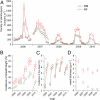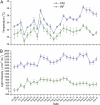Ecological mechanisms underlying the sustainability of the agricultural heritage rice-fish coculture system
- PMID: 22084110
- PMCID: PMC3250190
- DOI: 10.1073/pnas.1111043108
Ecological mechanisms underlying the sustainability of the agricultural heritage rice-fish coculture system
Abstract
For centuries, traditional agricultural systems have contributed to food and livelihood security throughout the world. Recognizing the ecological legacy in the traditional agricultural systems may help us develop novel sustainable agriculture. We examine how rice-fish coculture (RF), which has been designated a "globally important agricultural heritage system," has been maintained for over 1,200 y in south China. A field survey demonstrated that although rice yield and rice-yield stability are similar in RF and rice monoculture (RM), RF requires 68% less pesticide and 24% less chemical fertilizer than RM. A field experiment confirmed this result. We documented that a mutually beneficial relationship between rice and fish develops in RF: Fish reduce rice pests and rice favors fish by moderating the water environment. This positive relationship between rice and fish reduces the need for pesticides in RF. Our results also indicate a complementary use of nitrogen (N) between rice and fish in RF, resulting in low N fertilizer application and low N release into the environment. These findings provide unique insights into how positive interactions and complementary use of resource between species generate emergent ecosystem properties and how modern agricultural systems might be improved by exploiting synergies between species.
Conflict of interest statement
The authors declare no conflict of interest.
Figures







Comment in
-
Rice, fish, and the planet.Proc Natl Acad Sci U S A. 2011 Dec 13;108(50):19841-2. doi: 10.1073/pnas.1117707109. Epub 2011 Nov 30. Proc Natl Acad Sci U S A. 2011. PMID: 22135471 Free PMC article. No abstract available.
Similar articles
-
Rice, fish, and the planet.Proc Natl Acad Sci U S A. 2011 Dec 13;108(50):19841-2. doi: 10.1073/pnas.1117707109. Epub 2011 Nov 30. Proc Natl Acad Sci U S A. 2011. PMID: 22135471 Free PMC article. No abstract available.
-
Using aquatic animals as partners to increase yield and maintain soil nitrogen in the paddy ecosystems.Elife. 2022 Feb 22;11:e73869. doi: 10.7554/eLife.73869. Elife. 2022. PMID: 35190027 Free PMC article.
-
The sustainability of rice-crayfish coculture systems: a mini review of evidence from Jianghan plain in China.J Sci Food Agric. 2021 Jul;101(9):3843-3853. doi: 10.1002/jsfa.11019. Epub 2021 Jan 5. J Sci Food Agric. 2021. PMID: 33336495 Review.
-
Traditional agricultural management of Kam Sweet Rice (Oryza sativa L.) in southeast Guizhou Province, China.J Ethnobiol Ethnomed. 2022 Apr 7;18(1):30. doi: 10.1186/s13002-022-00528-6. J Ethnobiol Ethnomed. 2022. PMID: 35392930 Free PMC article.
-
Blue-green water utilization in rice-fish cultivation towards sustainable food production.Ambio. 2022 Sep;51(9):1933-1948. doi: 10.1007/s13280-022-01711-5. Epub 2022 Mar 4. Ambio. 2022. PMID: 35244893 Free PMC article. Review.
Cited by
-
Distinct bacterial communities in the environmental water, sediment and intestine between two crayfish-plant coculture ecosystems.Appl Microbiol Biotechnol. 2021 Jun;105(12):5087-5101. doi: 10.1007/s00253-021-11369-w. Epub 2021 Jun 4. Appl Microbiol Biotechnol. 2021. PMID: 34086119
-
Effect of nitrogen application rate on soil fungi community structure in a rice-fish mutualistic system.Sci Rep. 2019 Nov 7;9(1):16188. doi: 10.1038/s41598-019-52602-x. Sci Rep. 2019. PMID: 31700035 Free PMC article.
-
Recognizing wetland ecosystem services for sustainable rice farming in the Mekong Delta, Vietnam.Sustain Sci. 2017;12(1):137-154. doi: 10.1007/s11625-016-0409-x. Epub 2016 Nov 2. Sustain Sci. 2017. PMID: 30174748 Free PMC article.
-
Coordinative Management of Soil Resources and Agricultural Farmland Environment for Food Security and Sustainable Development in China.Int J Environ Res Public Health. 2023 Feb 12;20(4):3233. doi: 10.3390/ijerph20043233. Int J Environ Res Public Health. 2023. PMID: 36833927 Free PMC article. Review.
-
Human Schistosoma exposure risk in rice fields and an exploration of fish species for snail and schistosomiasis biocontrol.PLOS Glob Public Health. 2025 Jun 11;5(6):e0004726. doi: 10.1371/journal.pgph.0004726. eCollection 2025. PLOS Glob Public Health. 2025. PMID: 40498803 Free PMC article.
References
-
- Godfray HCJ, et al. Food security: The challenge of feeding 9 billion people. Science. 2010;327:812–818. - PubMed
-
- Brown ME, Funk CC. Climate. Food security under climate change. Science. 2008;319:580–581. - PubMed
-
- Piao SL, et al. The impacts of climate change on water resources and agriculture in China. Nature. 2010;467:43–51. - PubMed
-
- Mäder P, et al. Soil fertility and biodiversity in organic farming. Science. 2002;296:1694–1697. - PubMed
Publication types
MeSH terms
Substances
LinkOut - more resources
Full Text Sources

